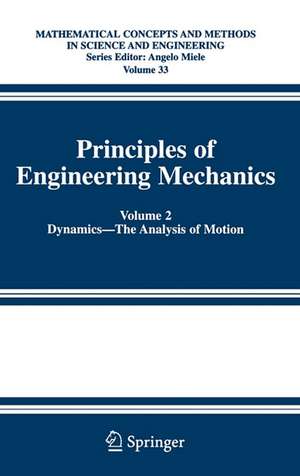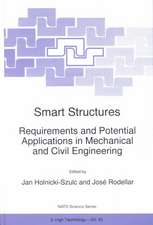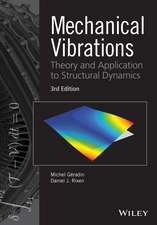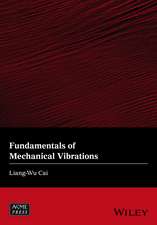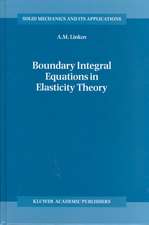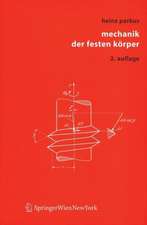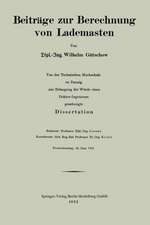Principles of Engineering Mechanics: Volume 2 Dynamics -- The Analysis of Motion: Mathematical Concepts and Methods in Science and Engineering, cartea 33
Autor Millard F. Beattyen Limba Engleză Hardback – 30 noi 2005
A key objective of these volumes, which present a vector treatment of the principles of mechanics, is to help the student gain confidence in transforming problems into appropriate mathematical language that may be manipulated to give useful physical conclusions or specific numerical results. In the first volume, the elements of vector calculus and the matrix algebra are reviewed in appendices. Unusual mathematical topics, such as singularity functions and some elements of tensor analysis, are introduced within the text. A logical and systematic building of well-known kinematic concepts, theorems, and formulas, illustrated by examples and problems, is presented offering insights into both fundamentals and applications. Problems amplify the material and pave the way for advanced study of topics in mechanical design analysis, advanced kinematics of mechanisms and analytical dynamics, mechanical vibrations and controls, and continuum mechanics of solids and fluids.
Volume I of Principles of Engineering Mechanics provides the basis for a stimulating and rewarding one-term course for advanced undergraduate and first-year graduate students specializing in mechanics, engineering science, engineering physics, applied mathematics, materials science, and mechanical, aerospace, and civil engineering. Professionals working in related fields of applied mathematics will find it a practical review and a quick reference for questions involving basic kinematics.
| Toate formatele și edițiile | Preț | Express |
|---|---|---|
| Paperback (1) | 485.43 lei 6-8 săpt. | |
| Springer Us – 26 mai 2011 | 485.43 lei 6-8 săpt. | |
| Hardback (1) | 604.70 lei 6-8 săpt. | |
| Springer Us – 30 noi 2005 | 604.70 lei 6-8 săpt. |
Din seria Mathematical Concepts and Methods in Science and Engineering
-
 Preț: 402.38 lei
Preț: 402.38 lei - 18%
 Preț: 782.07 lei
Preț: 782.07 lei -
 Preț: 395.47 lei
Preț: 395.47 lei -
 Preț: 386.39 lei
Preț: 386.39 lei -
 Preț: 397.59 lei
Preț: 397.59 lei -
 Preț: 400.10 lei
Preț: 400.10 lei -
 Preț: 384.31 lei
Preț: 384.31 lei -
 Preț: 384.48 lei
Preț: 384.48 lei -
 Preț: 390.08 lei
Preț: 390.08 lei -
 Preț: 382.75 lei
Preț: 382.75 lei -
 Preț: 386.39 lei
Preț: 386.39 lei - 20%
 Preț: 642.52 lei
Preț: 642.52 lei -
 Preț: 398.15 lei
Preț: 398.15 lei -
 Preț: 388.90 lei
Preț: 388.90 lei -
 Preț: 387.96 lei
Preț: 387.96 lei - 15%
 Preț: 653.79 lei
Preț: 653.79 lei - 20%
 Preț: 333.72 lei
Preț: 333.72 lei - 15%
 Preț: 639.25 lei
Preț: 639.25 lei - 20%
 Preț: 336.86 lei
Preț: 336.86 lei -
 Preț: 382.75 lei
Preț: 382.75 lei - 15%
 Preț: 653.00 lei
Preț: 653.00 lei -
 Preț: 391.02 lei
Preț: 391.02 lei - 18%
 Preț: 946.72 lei
Preț: 946.72 lei - 18%
 Preț: 956.69 lei
Preț: 956.69 lei -
 Preț: 388.90 lei
Preț: 388.90 lei - 18%
 Preț: 956.18 lei
Preț: 956.18 lei - 15%
 Preț: 644.63 lei
Preț: 644.63 lei - 18%
 Preț: 957.32 lei
Preț: 957.32 lei - 18%
 Preț: 1233.37 lei
Preț: 1233.37 lei - 18%
 Preț: 1233.52 lei
Preț: 1233.52 lei -
 Preț: 392.37 lei
Preț: 392.37 lei - 18%
 Preț: 957.94 lei
Preț: 957.94 lei - 15%
 Preț: 638.89 lei
Preț: 638.89 lei - 18%
 Preț: 950.03 lei
Preț: 950.03 lei - 15%
 Preț: 648.74 lei
Preț: 648.74 lei
Preț: 604.70 lei
Preț vechi: 711.41 lei
-15% Nou
Puncte Express: 907
Preț estimativ în valută:
115.71€ • 121.13$ • 95.74£
115.71€ • 121.13$ • 95.74£
Carte tipărită la comandă
Livrare economică 05-19 aprilie
Preluare comenzi: 021 569.72.76
Specificații
ISBN-13: 9780387237046
ISBN-10: 0387237046
Pagini: 595
Ilustrații: XXII, 595 p. 244 illus.
Dimensiuni: 152 x 229 x 32 mm
Greutate: 0.99 kg
Ediția:2006
Editura: Springer Us
Colecția Springer
Seria Mathematical Concepts and Methods in Science and Engineering
Locul publicării:New York, NY, United States
ISBN-10: 0387237046
Pagini: 595
Ilustrații: XXII, 595 p. 244 illus.
Dimensiuni: 152 x 229 x 32 mm
Greutate: 0.99 kg
Ediția:2006
Editura: Springer Us
Colecția Springer
Seria Mathematical Concepts and Methods in Science and Engineering
Locul publicării:New York, NY, United States
Public țintă
GraduateCuprins
The Foundation Principles of Classical Mechanics.- Dynamics of a Particle.- Momentum, Work, and Energy.- Dynamics of a System of Particles.- The Moment of Inertia Tensor.- Dynamics of a Rigid Body.- to Advanced Dynamics.
Recenzii
From the reviews:
"The book is the second of two volumes on principles of engineering mechanics. … The book can serve as a basis for a course and a self-study for advanced undergraduate or first-year graduate students, specializing in mechanics, engineering science, engineering physics, applied mathematics, material science, mechanical, aerospace and civil engineering. … Interesting historical remarks are scattered throughout the text, and extensive lists of references with short annotations follow each chapter." (Boris Ivanovich Konosevich, Zentralblatt MATH, Vol. 1113 (15), 2007)
"The book is the second of two volumes on principles of engineering mechanics. … The book can serve as a basis for a course and a self-study for advanced undergraduate or first-year graduate students, specializing in mechanics, engineering science, engineering physics, applied mathematics, material science, mechanical, aerospace and civil engineering. … Interesting historical remarks are scattered throughout the text, and extensive lists of references with short annotations follow each chapter." (Boris Ivanovich Konosevich, Zentralblatt MATH, Vol. 1113 (15), 2007)
Textul de pe ultima copertă
Separation of the elements of classical mechanics into kinematics and dynamics is an uncommon tutorial approach, but the author uses it to advantage in this two-volume set. Students gain a mastery of kinematics first – a solid foundation for the later study of the free-body formulation of the dynamics problem.
A key objective of these volumes, which present a vector treatment of the principles of mechanics, is to help the student gain confidence in transforming problems into appropriate mathematical language that may be manipulated to give useful physical conclusions or specific numerical results. In the first volume, the elements of vector calculus and the matrix algebra are reviewed in appendices. Unusual mathematical topics, such as singularity functions and some elements of tensor analysis, are introduced within the text. A logical and systematic building of well-known kinematic concepts, theorems, and formulas, illustrated by examples and problems, is presented offering insights into both fundamentals and applications. Problems amplify the material and pave the way for advanced study of topics in mechanical design analysis, advanced kinematics of mechanisms and analytical dynamics, mechanical vibrations and controls, and continuum mechanics of solids and fluids.
Volume I of Principles of Engineering Mechanics provides the basis for a stimulating and rewarding one-term course for advanced undergraduate and first-year graduate students specializing in mechanics, engineering science, engineering physics, applied mathematics, materials science, and mechanical, aerospace, and civil engineering. Professionals working in related fields of applied mathematics will find it a practical review and a quick reference for questions involving basic kinematics.
A key objective of these volumes, which present a vector treatment of the principles of mechanics, is to help the student gain confidence in transforming problems into appropriate mathematical language that may be manipulated to give useful physical conclusions or specific numerical results. In the first volume, the elements of vector calculus and the matrix algebra are reviewed in appendices. Unusual mathematical topics, such as singularity functions and some elements of tensor analysis, are introduced within the text. A logical and systematic building of well-known kinematic concepts, theorems, and formulas, illustrated by examples and problems, is presented offering insights into both fundamentals and applications. Problems amplify the material and pave the way for advanced study of topics in mechanical design analysis, advanced kinematics of mechanisms and analytical dynamics, mechanical vibrations and controls, and continuum mechanics of solids and fluids.
Volume I of Principles of Engineering Mechanics provides the basis for a stimulating and rewarding one-term course for advanced undergraduate and first-year graduate students specializing in mechanics, engineering science, engineering physics, applied mathematics, materials science, and mechanical, aerospace, and civil engineering. Professionals working in related fields of applied mathematics will find it a practical review and a quick reference for questions involving basic kinematics.
